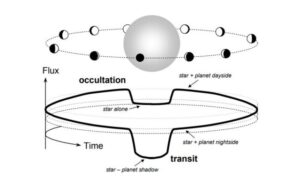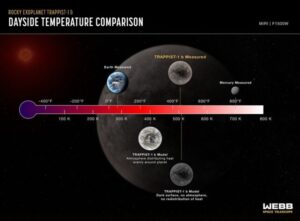Hello, space enthusiasts! Welcome to another exciting episode of Exoplanet Explorers, where we bring you the latest news and discoveries from the fascinating field of exoplanet science.
Today, we have a special treat for you: we’re going to talk about the first results from the James Webb Space Telescope (JWST), the most powerful and advanced space observatory ever built, which launched in December 2021.
As you may know, JWST is designed to study the infrared light from distant objects in the Universe, such as galaxies, stars, and planets. One of its main goals is to characterize the atmospheres of exoplanets, especially those that are similar in size and temperature to Earth. By analyzing the infrared spectra of these planets, JWST can reveal what gases are present in their atmospheres, and how they affect their climates and habitability.
One of the most intriguing targets for JWST is the TRAPPIST-1 system, a group of seven Earth-sized planets orbiting a cool red dwarf star about 40 light-years away from us. Three of these planets are located in the star’s habitable zone, where liquid water could exist on their surfaces. The TRAPPIST-1 system is a unique laboratory for studying how different environmental conditions arise on rocky worlds, and how they might support life.
The first planet that JWST observed in this system was TRAPPIST-1b, the innermost and hottest one. It completes one orbit around its star in just 1.5 days, and receives four times more radiation than Earth does from the Sun. Previous observations with other telescopes suggested that TRAPPIST-1b probably does not have a thick hydrogen-rich atmosphere, but they could not rule out the possibility of a denser atmosphere made of heavier molecules, such as carbon dioxide or water.
 |
| A diagram of the changes in a star’s light as an exoplanet orbits. (J. Winn, arXiv, 2014) |
JWST used a technique called thermal emission spectroscopy to measure the infrared light emitted by TRAPPIST-1b as it passed behind its star. This allowed the astronomers to estimate the temperature and brightness of the planet, and to look for any signs of an atmosphere. The results were published in Nature on March 27th, 2023.
The researchers found that TRAPPIST-1b has a surface temperature of about 230 degrees Celsius (446 degrees Fahrenheit), and that it emits almost as much infrared light as a blackbody, an ideal object that absorbs and radiates all wavelengths equally. This means that TRAPPIST-1b probably does not have an atmosphere at all, or at least not one that can redistribute heat efficiently across its surface. The planet also showed no evidence of carbon dioxide in its spectrum, which would have been detectable by JWST.
These findings are not surprising, given the intense radiation and stellar activity that TRAPPIST-1b experiences from its host star. The planet may have lost its original atmosphere over time due to erosion by stellar winds and flares. However, they are still very important for understanding the evolution and diversity of rocky planets around red dwarf stars, which are the most common type of stars in our galaxy.
The team plans to use JWST to observe the other six planets in the TRAPPIST-1 system, and to compare their properties and atmospheres. They hope to find out which ones are more likely to be habitable, and what factors influence their suitability for life. They also hope to detect biosignatures, such as oxygen or methane, that could indicate the presence of living organisms on these worlds.
JWST has opened a new window into the exploration of exoplanets, and we can expect many more exciting discoveries in the coming years. Stay tuned for more updates from Exoplanet Explorers, and don’t forget to subscribe to our channel for more awesome content about space science. Until next time, keep looking up!
Reference(s):



